Recovery of Rare Earth Oxides from Flotation Concentrates of Bastnaesite Ore by Ultra-Fine Centrifugal Concentration
Abstract
:1. Introduction
1.1. Ultra-Fine Falcon Concentrators
1.2. Whole Ore Gravity Testing via Methods Other Than UF Falcon
2. Materials and Methods
2.1. Materials
2.2. UF Falcon Scoping Testing
2.3. UF Falcon Concentrator DOE Testing
2.4. UF Falcon REO Recovery and Grade Maximization Testing
3. Results and Discussion
3.1. Characterization and Mineralogy
3.2. UF Falcon DOE Matrix Results
3.3. UF Falcon REO Recovery Maximization Results
3.4. UF Falcon REO Grade Maximization Results
3.5. Williams’ UF Falcon Results
4. Conclusions
Author Contributions
Funding
Institutional Review Board Statement
Informed Consent Statement
Data Availability Statement
Acknowledgments
Conflicts of Interest
References
- Falconer, A. Gravity separation: Old technique/new methods. Phys. Sep. Sci. Eng. 2003, 12, 31–48. [Google Scholar] [CrossRef] [Green Version]
- Knelson, B. The Knelson Concentrator. Metamorphosis from Crude Beginning to Sophisticated World Wide Acceptance. Miner. Eng. 1992, 5, 1091–1097. [Google Scholar] [CrossRef]
- Deveau, C.; Young, S. Pushing the Limits of Gravity Separation. Available online: https://minerals.seprosystems.com/wp-content/uploads/2019/09/Pushing-the-Limits-of-Gravity-Separation-1-1.pdf (accessed on 17 May 2017).
- Deveau, C. Improving Fine Particle Gravity Recovery through Equipment Behavior Modification. In Proceedings of the 38th Annual Canadian Mineral Processors Conference, Ottawa, ON, Canada, 17–19 January, 2006; pp. 501–517. [Google Scholar]
- Sepro UF Falcon Website. Available online: https://seprosystems.com/products/gravity-concentrators/_falcon-uf-gravity-concentrators/ (accessed on 22 July 2018).
- Jordens, A.; Cheng, Y.P.; Waters, K.E. A Review of the Benefication of Rare Earth Element Bearing Minerals. Miner. Eng. 2013, 41, 97–114. [Google Scholar] [CrossRef]
- Chapleski, R.C., Jr.; Chowdhury, A.U.; Wanhala, A.K.; Bocharova, V.; Roy, S.; Keller, P.C.; Bryantsev, V.S. A Molecular-Scale Approach to Rare-Earth Beneficiation: Thinking Small to Avoid Large Losses. IScience 2020, 23. [Google Scholar] [CrossRef] [PubMed]
- Everly, D. Surface Chemistry of Novel Collectors and their Application to Froth Flotation of Rare Earth Minerals. MSc Thesis, Colorado School of Mines, Golden, CO, USA, 2018. [Google Scholar]
- Williams, N. Bastnaesite Beneficiation by Froth Flotation and Gravity Separation. MSc Thesis, Colorado School of Mines, Golden, CO, USA, 2018. [Google Scholar]
- Kroll-Rabotin, J.S.; Bourgeois, F.; Climent, E. Physical Analysis and Modeling of the Falcon Concentrator for Beneficiation of Ultrafine Particles. Int. J. Miner. Process. 2013, 121, 39–50. [Google Scholar] [CrossRef] [Green Version]
- Schriner, D.; Anderson, C. Centrifugal Concentration of Rare Earth Minerals from Calcite Gangue. J. Metall. Eng. (ME) 2015, 4. [Google Scholar] [CrossRef]
- Grewal, I.; Neale, A. Enhanced Gravity Recovery of Base Metals and Industrial Minerals, In Proceedings of the 49th Annual Canadian Mineral Processors Operators Conference. Ottawa, ON, Canada, 17–19 January, 2017; pp. 362–373. [Google Scholar]
- Grewal, I.; Sepro Mineral Systems, Langley, Canada; Norgen, A.; Colorado School of Mines, Golden, CO, USA. Personal communication, 2017.
- Norgren, A. Ultra-Fine Gravity Separation Of Rare Earth Minerals. MSc Thesis, Colorado School of Mines, Golden, CO, USA, 2018. [Google Scholar]
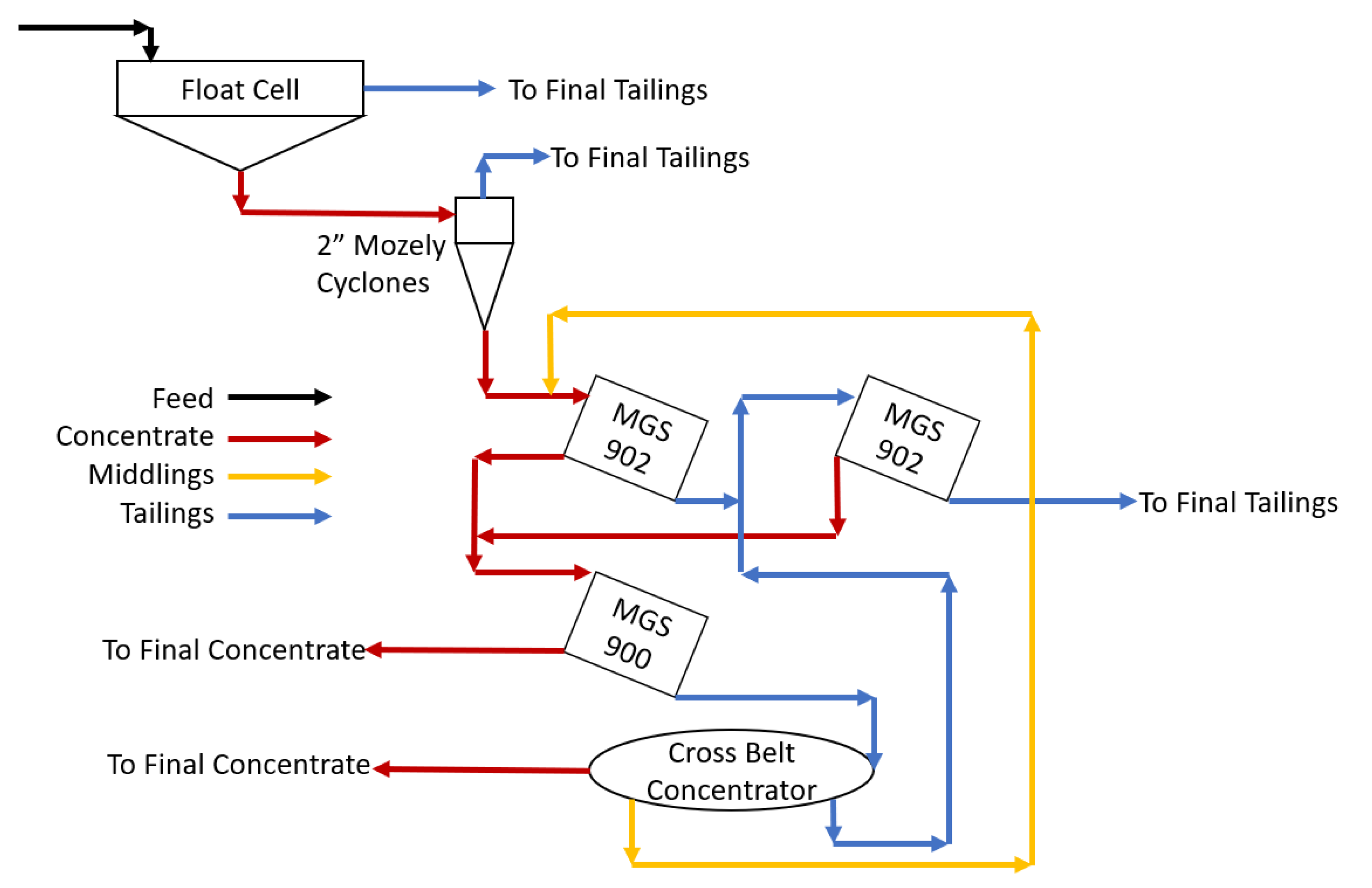
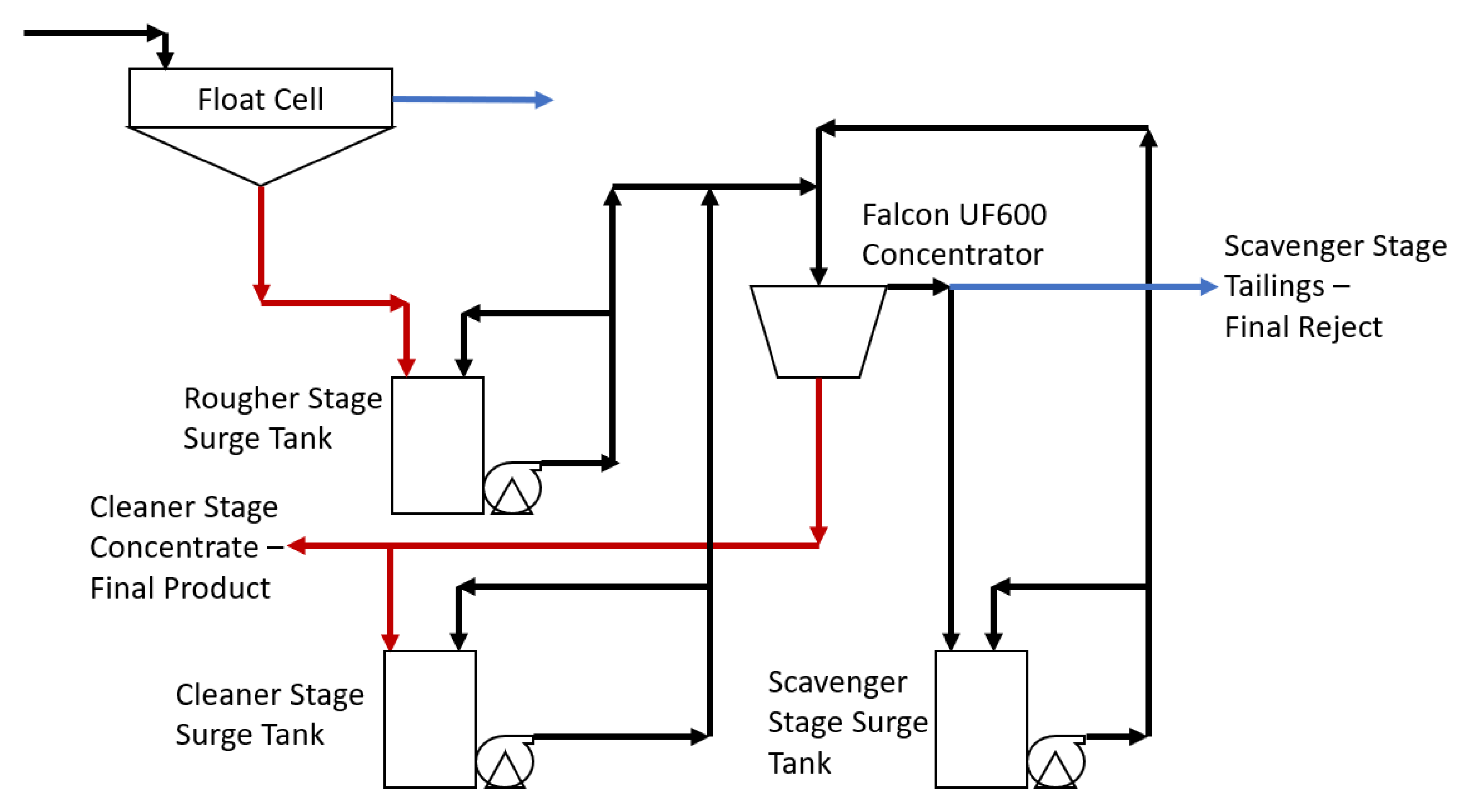
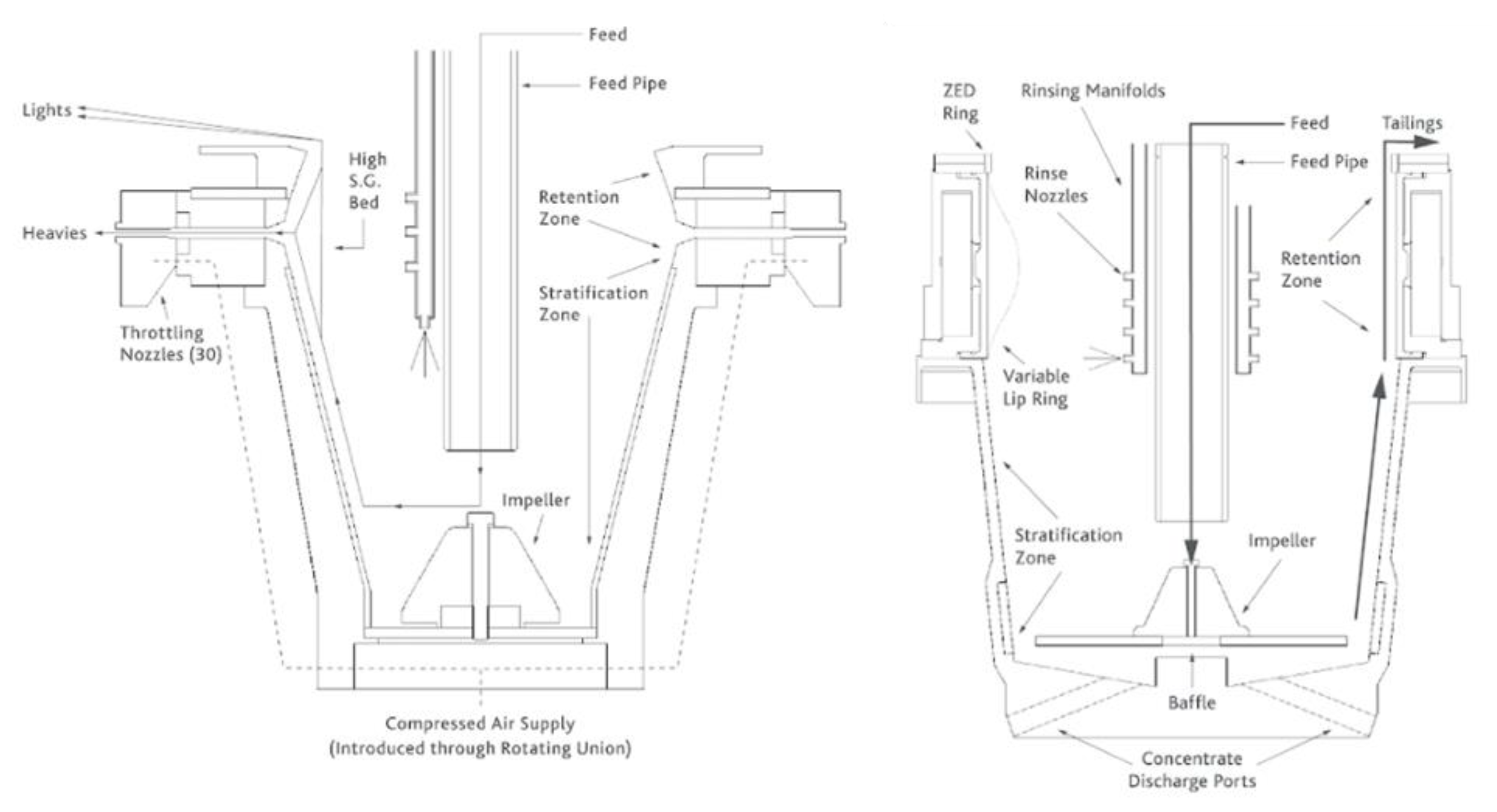
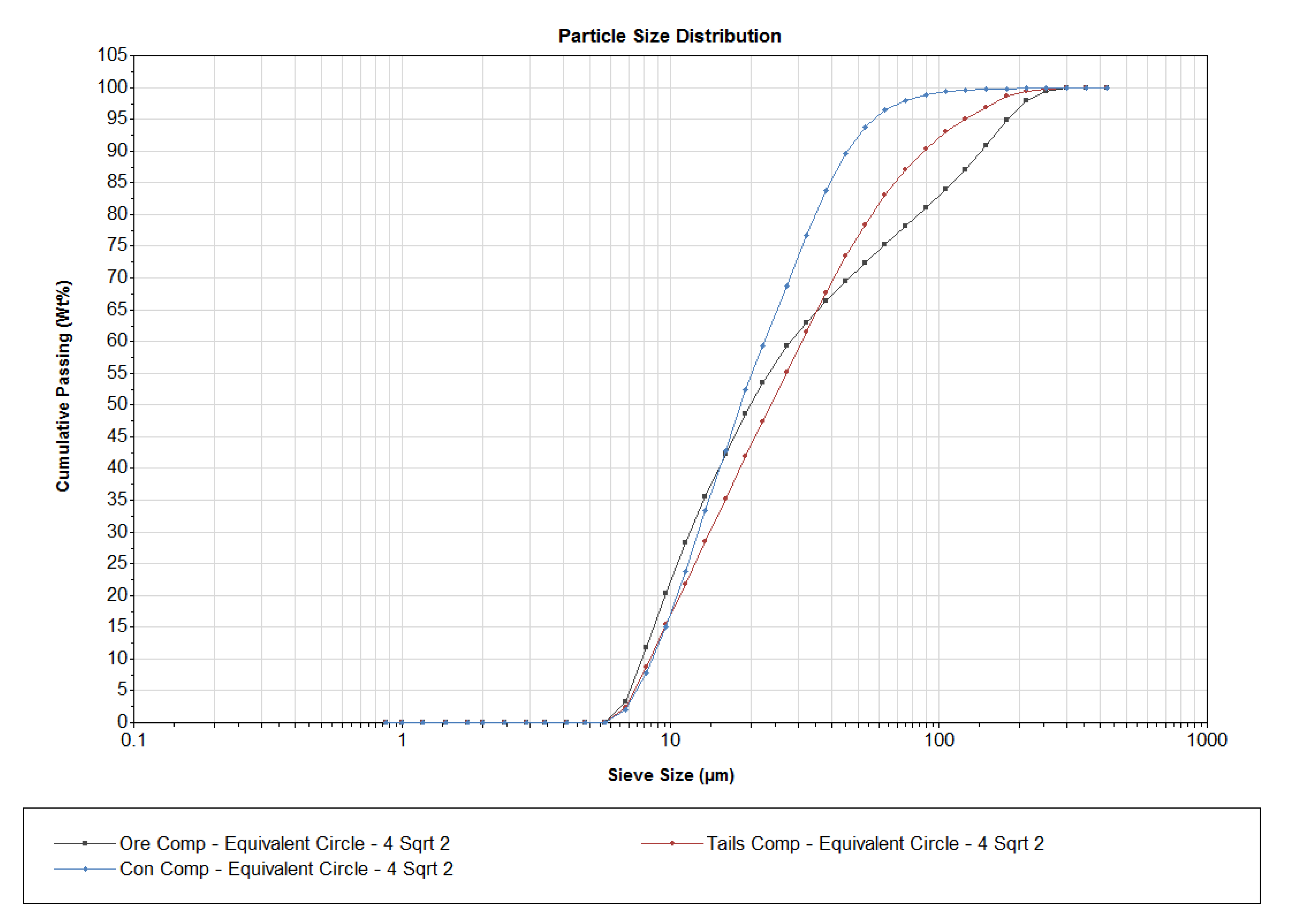
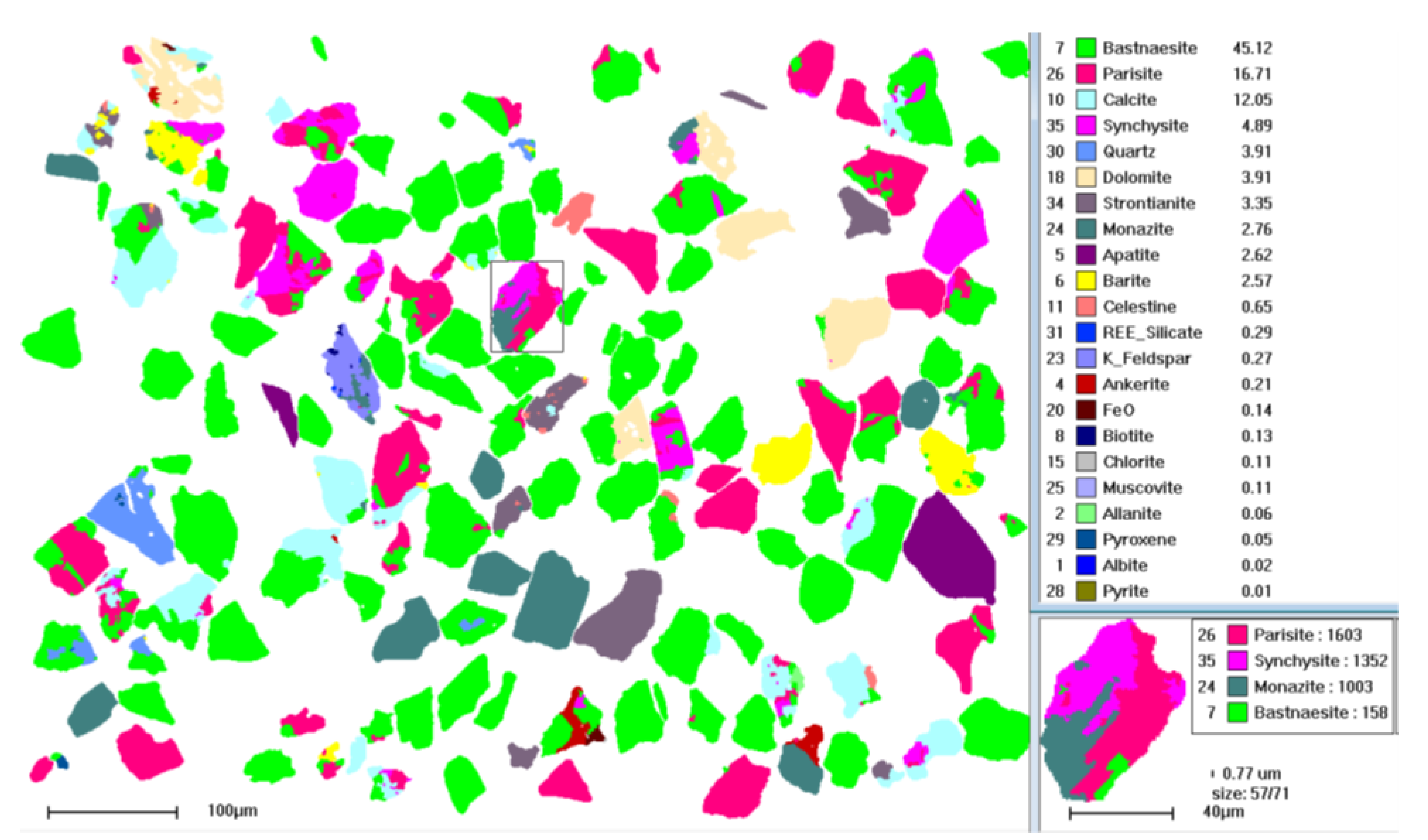
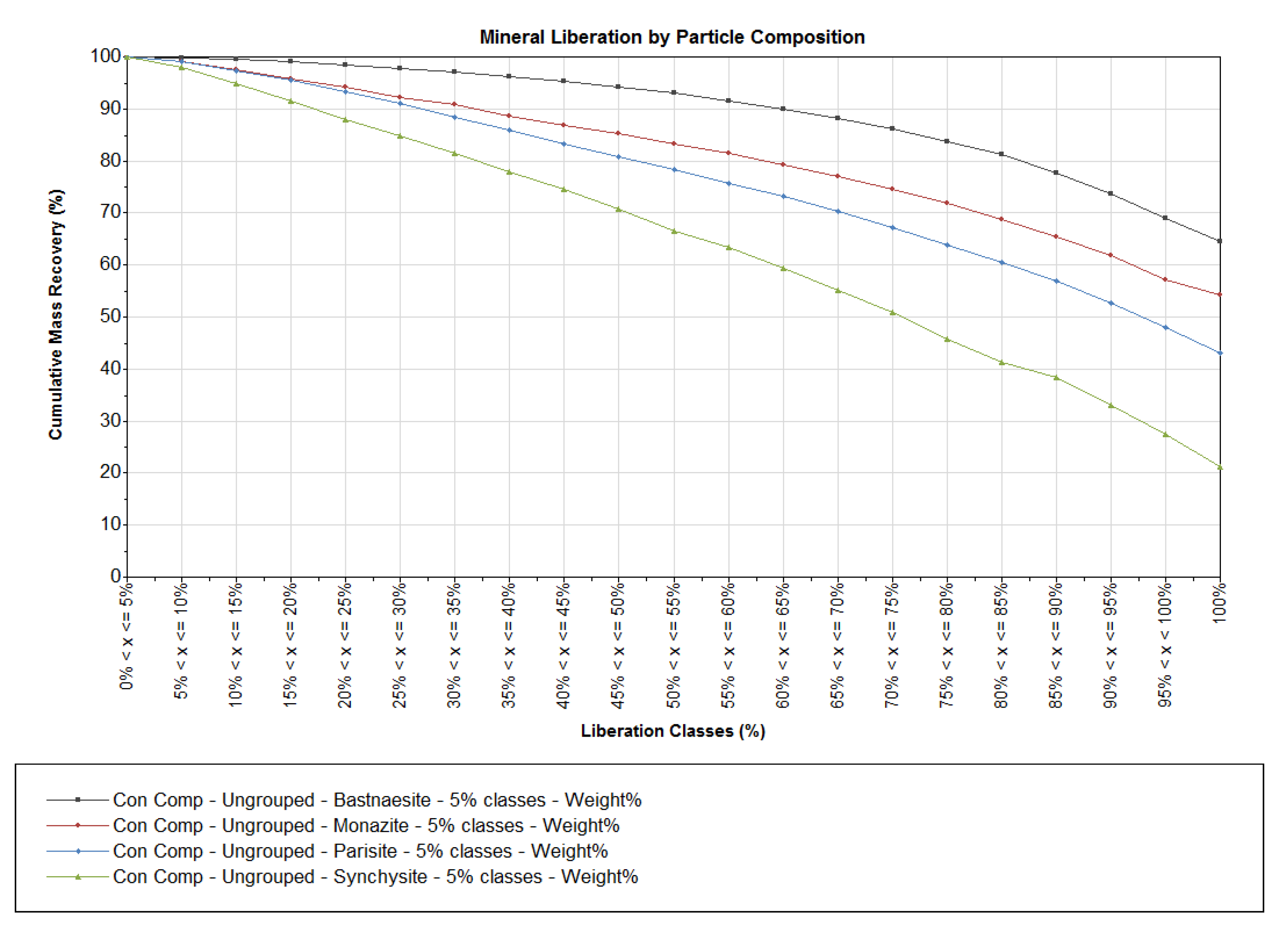

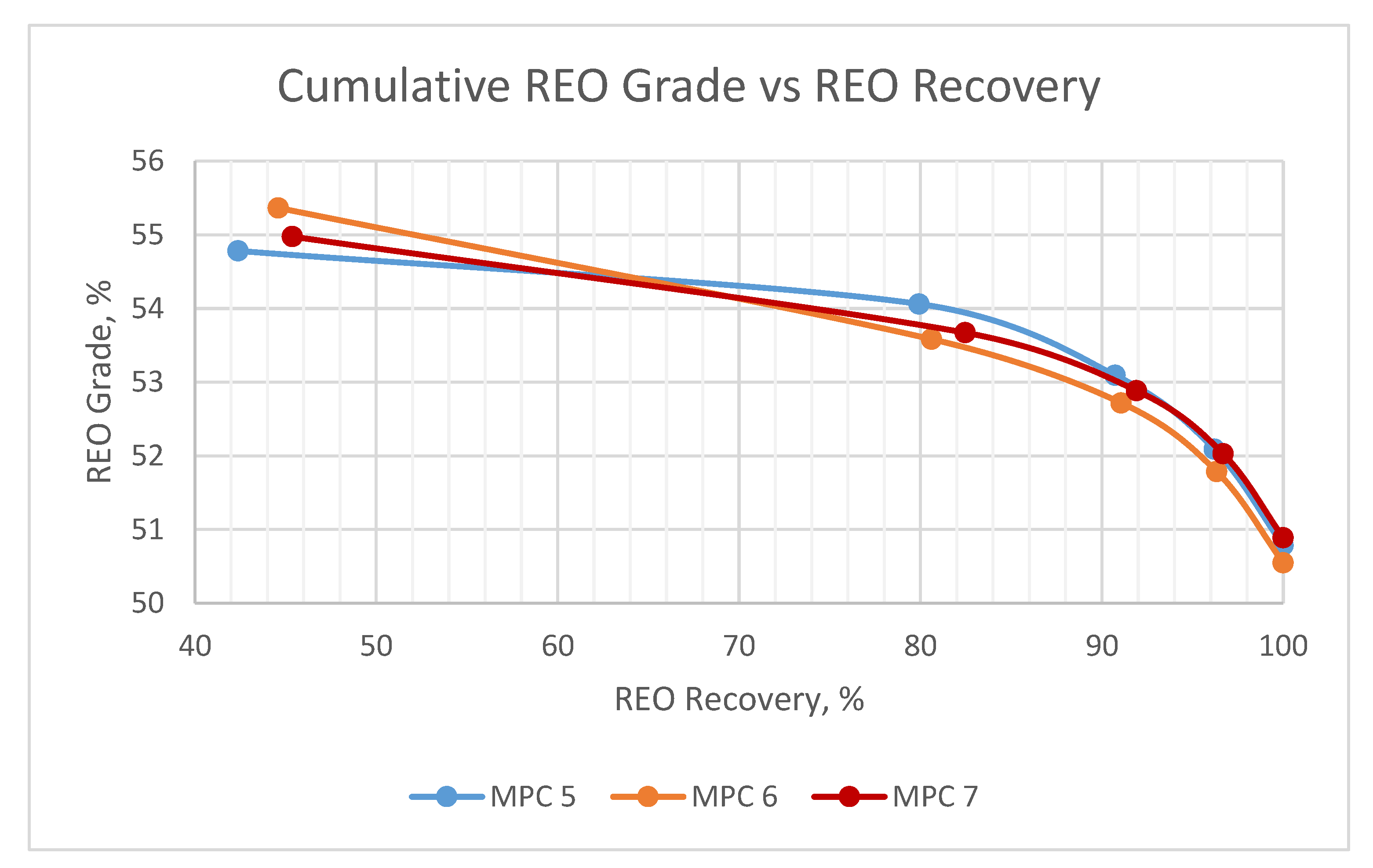

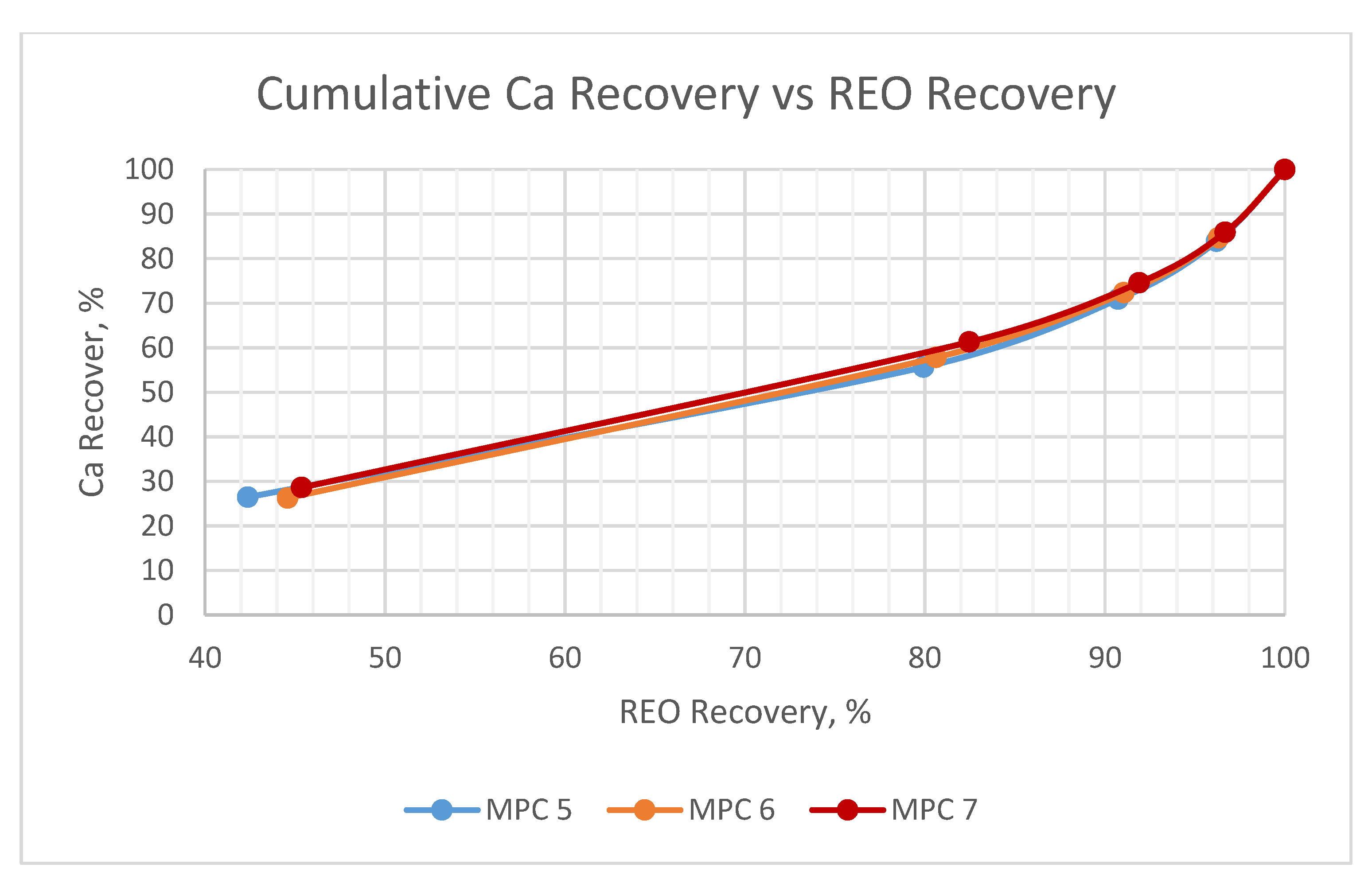
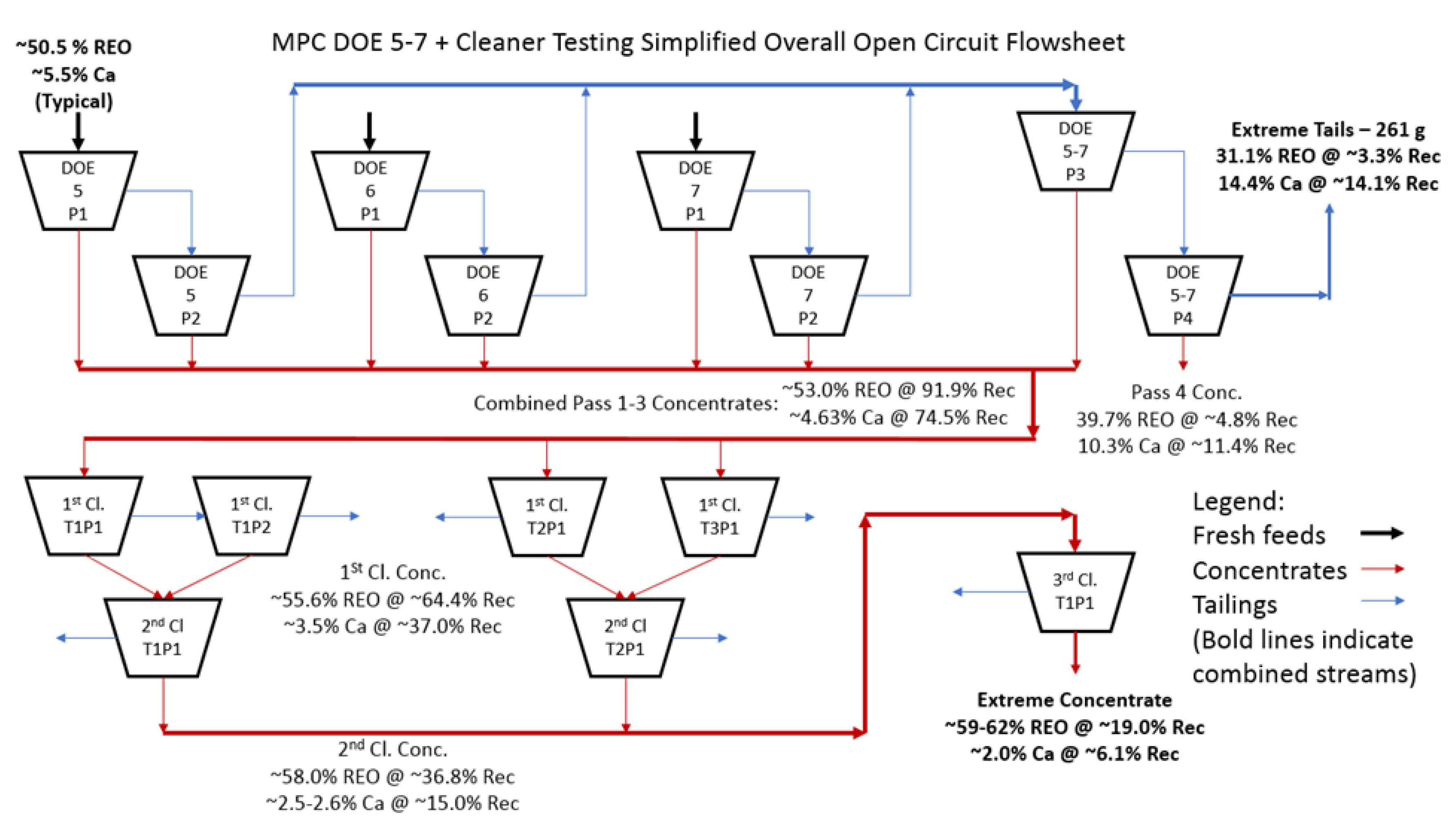
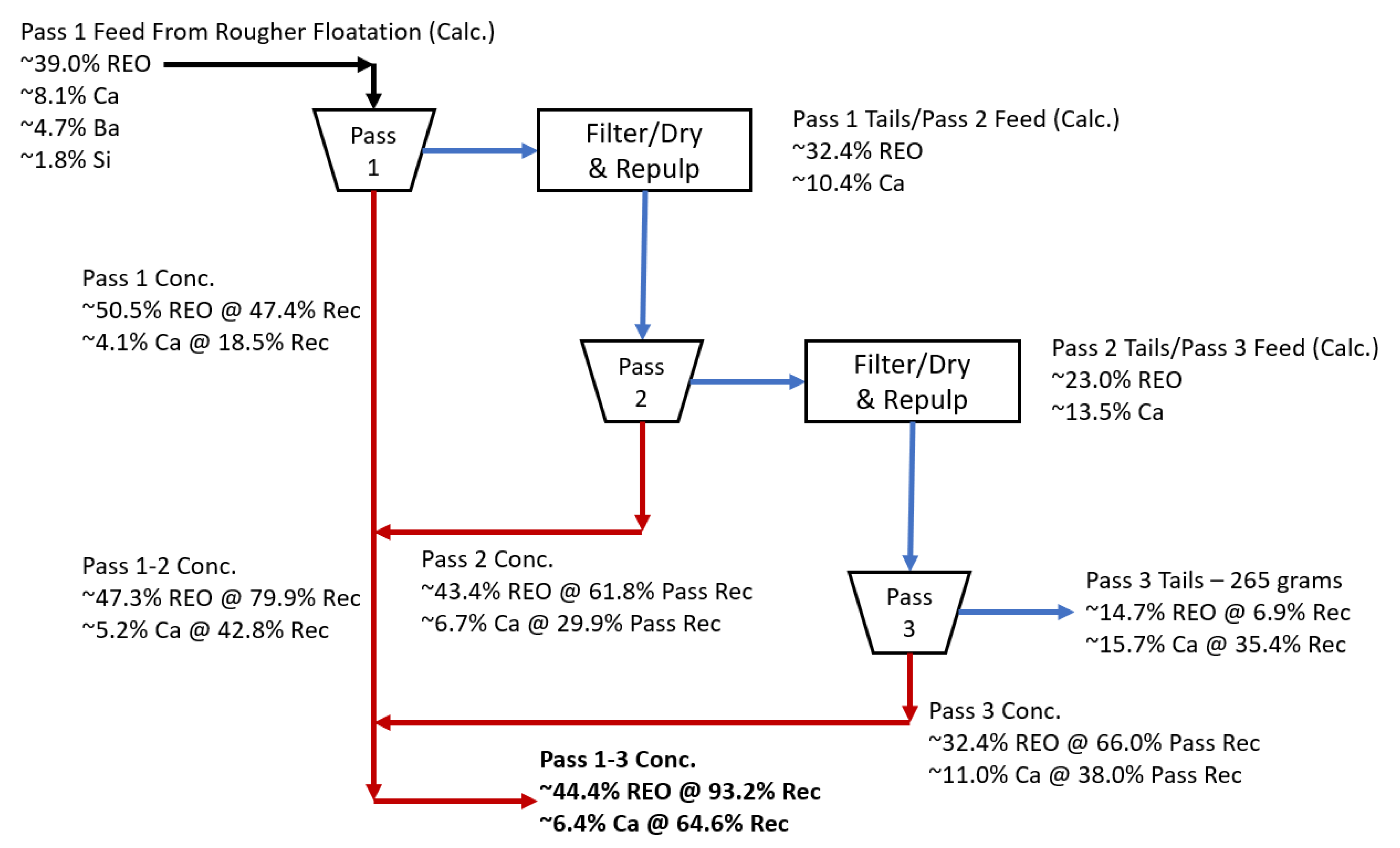
| Mineral | Formula | 100 | 100 × 200 | 200 × 400 | 400 × 500 | −500 | Modal |
|---|---|---|---|---|---|---|---|
| Bastnaesite | (Ce0.5La0.4Nd0.1)(CO3)F | 51.4 | 36.5 | 53 | 60.6 | 57.9 | 56.9 |
| Parisite | Ca(Ce0.4La0.3Nd0.3)2(CO3)3F2 | 11.8 | 13 | 17 | 15.4 | 15.5 | 15.7 |
| Monazite | (La,Ce)PO4 | 2.84 | 1.43 | 3.31 | 4.5 | 6.65 | 5.54 |
| Synchysite | Ca(Ce0.5La0.4Nd0.1)(CO3)2F | 2.68 | 3.77 | 4.48 | 4.03 | 3.26 | 3.62 |
| Total REE Minerals | - | 68.72 | 54.7 | 77.79 | 84.53 | 83.31 | 81.76 |
| Calcite | CaCO3 | 9.19 | 19.9 | 7.67 | 4.57 | 7.3 | 7.23 |
| Dolomite | CaMg(CO3)2 | 4.29 | 7.89 | 2.62 | 1.05 | 0.54 | 1.2 |
| Barite | BaSO4 | 6.65 | 3.55 | 2.66 | 1.88 | 1.60 | 1.92 |
| Quartz | SiO2 | 4.33 | 6.1 | 2.44 | 1.21 | 0.67 | 1.23 |
| Celestine | SrSO4 | 0.91 | 0.77 | 0.61 | 0.52 | 0.57 | 0.58 |
| Strontianite | SrCO3 | 1.08 | 1.42 | 2.96 | 3.95 | 4.06 | 3.76 |
| Other | - | 4.83 | 5.67 | 3.25 | 2.29 | 1.95 | 2.32 |
| Mineral | Formula | MP Whole Ore | MP Final Tailings | Williams’ Gravity Conc. | MPC UF 3rd Cl Conc | MPC UF P4 Tails |
|---|---|---|---|---|---|---|
| Bastnaesite | (Ce0.5La0.4Nd0.1)(CO3)F | 12.9 | 5.1 | 56.9 | 75.7 | 29.7 |
| Parisite | Ca(Ce0.4La0.3Nd0.3)2(CO3)3F2 | 1.81 | 0.72 | 15.7 | 8.43 | 15.3 |
| Monazite | (La,Ce)PO4 | 0.84 | 0.74 | 5.54 | 7.53 | 3.73 |
| Synchysite | Ca(Ce0.5La0.4Nd0.1)(CO3)2F | 0.67 | 0.18 | 3.62 | 2.49 | 8.74 |
| Total REE minerals | - | 16.23 | 7.02 | 81.76 | 94.2 | 58.4 |
| Calcite | CaCO3 | 21.3 | 28.6 | 7.23 | 1.3 | 24.2 |
| Dolomite | CaMg(CO3)2 | 16.2 | 13.0 | 1.2 | 0.23 | 3.83 |
| Barite | BaSO4 | 20.9 | 25.0 | 1.92 | 1.02 | 2.54 |
| Quartz | SiO2 | 5.97 | 8.39 | 1.23 | 0.19 | 2.82 |
| Celestine | SrSO4 | 8.59 | 3.29 | 0.58 | 0.22 | 0.32 |
| Strontianite | SrCO3 | 1.57 | 1.74 | 3.76 | 2.11 | 3.55 |
| Other | - | 9.24 | 12.96 | 2.32 | 0.70 | 4.4 |
| Test | Conditions | Grav Conc Mass | Grade, % | Recovery, % | ||||
|---|---|---|---|---|---|---|---|---|
| (MPC) | RPM | Pulp, wt% | Grams | Rec, % | Ca | REO | Ca | REO |
| DOE 1 | 930 | 20 | 680.4 | 41.13 | 3.63 | 55.26 | 28.9 | 44.51 |
| DOE 2 | 930 | 10 | 603.4 | 37.39 | 4.37 | 53.85 | 28.93 | 39.83 |
| DOE 3 | 1320 | 20 | 633.4 | 38.61 | 3.83 | 53.79 | 24.65 | 41.61 |
| DOE 4 | 1320 | 10 | 546.1 | 36.61 | 3.66 | 55.49 | 24.85 | 39.82 |
| DOE 5 | 1141 | 15 | 612.7 | 39.28 | 3.74 | 54.78 | 26.74 | 42.12 |
| DOE 6 | 1141 | 15 | 630.7 | 40.72 | 3.62 | 55.37 | 27.43 | 44.09 |
| DOE 7 | 1320 | 15.1 | 608.6 | 42.00 | 3.79 | 54.98 | 28.63 | 45.46 |
Publisher’s Note: MDPI stays neutral with regard to jurisdictional claims in published maps and institutional affiliations. |
© 2021 by the authors. Licensee MDPI, Basel, Switzerland. This article is an open access article distributed under the terms and conditions of the Creative Commons Attribution (CC BY) license (https://creativecommons.org/licenses/by/4.0/).
Share and Cite
Norgren, A.; Anderson, C. Recovery of Rare Earth Oxides from Flotation Concentrates of Bastnaesite Ore by Ultra-Fine Centrifugal Concentration. Metals 2021, 11, 1498. https://doi.org/10.3390/met11091498
Norgren A, Anderson C. Recovery of Rare Earth Oxides from Flotation Concentrates of Bastnaesite Ore by Ultra-Fine Centrifugal Concentration. Metals. 2021; 11(9):1498. https://doi.org/10.3390/met11091498
Chicago/Turabian StyleNorgren, Alex, and Corby Anderson. 2021. "Recovery of Rare Earth Oxides from Flotation Concentrates of Bastnaesite Ore by Ultra-Fine Centrifugal Concentration" Metals 11, no. 9: 1498. https://doi.org/10.3390/met11091498
APA StyleNorgren, A., & Anderson, C. (2021). Recovery of Rare Earth Oxides from Flotation Concentrates of Bastnaesite Ore by Ultra-Fine Centrifugal Concentration. Metals, 11(9), 1498. https://doi.org/10.3390/met11091498






